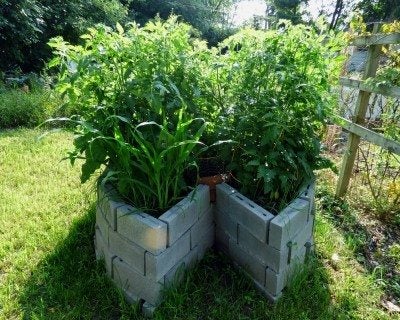Keyhole Garden Beds - How To Make A Keyhole Garden


Keyhole garden beds are commonly seen in permaculture gardens. These beautiful, productive gardens are ideal for small spaces and can accommodate a variety of plants like vegetables, herbs, flowers, and more. In addition, permaculture keyhole gardening can be easily adapted to fit the individual needs of the gardener.
How to Make a Keyhole Garden
In a permaculture keyhole garden, plants that are used on a regular basis (and those that require the most upkeep) are placed nearest the home, for quick and easy access. By using creative patterns and designs, gardeners can increase productivity, especially with the use of keyhole garden beds. These beds can be designed in a number of ways, depending on the gardener's needs and preferences. Typically, however, keyhole gardens are horseshoe shaped or circular (like a keyhole) so they can be easily reached from all sides. As for how to make a keyhole garden, there are various methods for its construction. One of the best and most common methods for keyhole gardening construction is the use of raised beds. Raised beds are most preferred, as they reduce the need for bending or stooping while performing garden maintenance. They're well suited for nearly any plant, especially perennials, which have deeper root systems and require less water.
Design and Build Keyhole Raised Beds
Place a stake in the ground to measure the center, attaching a string and measuring out about 24 inches (60 cm.) around. Then, measure out about 5-6 feet (1.5-1.8 m.) from the stake, which will become the outer perimeter of your garden bed. You can then build keyhole raised beds by building up the soil with stones, boards, or anything that will hold dirt in your desired shape to a height of about 3-4 feet (0.9-1.2 m.). Sheet mulching is another method for implementing keyhole garden beds. These beds are placed on existing lawn or dirt without the need for digging, and can eventually be built up into raised designs as well. Wet newspaper or cardboard is placed on the chosen site (in the desired shape). A layer of straw is then added over top with a layer of compost and soil applied along the outer edges (for plantings), with an opening left for entry. Larger keyhole gardens can also be constructed with a center planting or focal point such as a small ornamental tree, shrub, or water feature. Another method for building a keyhole garden involves the construction of a rock wall around a center water-catching basket. Find or level off an area of ground about 6.5 feet (2 m.) in diameter, near the home is best for easy access to water. Mark the perimeter of the center water catch basket with four sticks, which will be about 16 inches (40 cm.) wide and 5 feet (1.5 m.) tall. However, it's important to note that measurement is flexible and can be changed to fit your needs. Tie the four sticks together with string and line the basket with a permeable lining. The outer edges will consist of a wall of flat stones that will gradually be built up to 4 feet (1.2 m.) high. Again, this is up to you. Don't forget to leave a keyhole opening about 1.5-2 feet (45-60 cm.) wide. The floor of the keyhole garden is made up of compost that includes a layer of kitchen scraps, followed by a layer of sticks, twigs, and dry leaves, followed by soil and repeated. Keyhole gardening is perfect for anyone who wants to grow productive, organic plants in any climate, in any space with little effort.
Gardening tips, videos, info and more delivered right to your inbox!
Sign up for the Gardening Know How newsletter today and receive a free copy of our e-book "How to Grow Delicious Tomatoes".

Nikki Tilley has been gardening for nearly three decades. The former Senior Editor and Archivist of Gardening Know How, Nikki has also authored six gardening books.
-
 Try The Trend – Turn Any Bed Into A Keyhole Garden With This Clever In-Ground Composter
Try The Trend – Turn Any Bed Into A Keyhole Garden With This Clever In-Ground ComposterKeyhole gardening is an efficient and sustainable practice that saves space. Get started on this DIY project quickly and easily with an in-ground composter.
By Bonnie L. Grant
-
 4 Superfast Composting Methods: Turn Waste Into Garden Gold In 30 Days Or Less
4 Superfast Composting Methods: Turn Waste Into Garden Gold In 30 Days Or LessTry the fastest composting methods to turbocharge your pile and transform kitchen scraps and garden waste into finished compost in just a few weeks.
By Mary Ellen Ellis